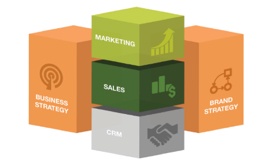Doug Wendt is a co-founder and senior partner with Wendt Partners.
The result is what we call the B2B Growth Stack — an integrated model containing five key building blocks that, collectively set the stage for planning and executing a successful and sustainable growth strategy for a company in the technology, professional services or industrial space. The five elements are further organized into two strategic pillars and three execution elements.
The following are the five building blocks in the B2B Growth Stack and key points about what comprises each:
The Strategic Pillars

The strategic pillars set the boundaries of the growth strategy by aligning the company and its objectives with the marketplace and its needs. The two strategic pillars are as follows:
Business Strategy - The first of the five elements is business strategy, which focuses on what the owners and investors want to accomplish with the enterprise, and how that relates to the current state of the business. Key components within business strategy include the owner’s objectives, target markets, the business model, product or service offerings, and customer segments.
Brand Strategy - Contrary to popular belief, brand strategy is not about what your business wants to communicate to the marketplace. Rather, it is about what the marketplace needs and wants that you can effectively and competitively deliver — and then building a messaging framework around that match. Key components within brand strategy include your brand vision and promise, value proposition, messaging & positioning, buyer personas and competitive benchmarking.
The Execution Stack
Once we’ve established the two strategic pillars that connect the company to the marketplace, it’s time to dig into the execution stack at the center of the model. There are three elements in the execution stack, and they should be addressed in a specific order, going from bottom to top. The three execution elements are:
CRM (Customer Relationship Management) - This is hands-down the most commonly ignored element of growth strategy, and ironically, it is the most important. There is simply no point in investing in marketing or sales without a proper CRM strategy at the core. The goal of a CRM system is to provide a single, core record and platform for knowing your customers and prospects — it is the goldmine of your future growth. Key components within CRM include business relationships, target accounts, contact sources, prospect profiling and data quality.
Sales - It’s interesting to note that the traditional model of growth strategy places marketing before sales. The logic behind this is to follow the flow of a lead — from marketing’s role in lead generation toward sales’ role in qualifying leads and turning them into opportunities that eventually result in a sale. The reality is that we are better off reverse-engineering the process since sales can tell us what a ‘best fit’ prospect is, and this can, in turn, inform marketing. Within sales, we’re including components such as lead generation and nurturing, pipeline and opportunity management, sales enablement, sales acceleration and social selling.
Marketing - With sales defining the type of prospect that is a ‘best fit’ for success and creating the framework by which the sales pipeline can be effectively filled, it’s now marketing’s job to build and deliver the infrastructure that makes this possible. Key elements in this include the brand foundation, digital presence, content and inbound, channels and partners, and programs and public relations.
The research shows that when companies effectively ‘connect the dots’ between these five elements, they find themselves far better positioned to achieve sustainable growth over time. This means getting past the ‘rifle-shot’ experiences from various campaigns that deliver temporary but unsustainable revenue boosts, and into a model of building the business organically with all of the right elements working in an integrated and harmonious manner. The result is a powerful and sustainable growth strategy for the business that will last well into the future.








